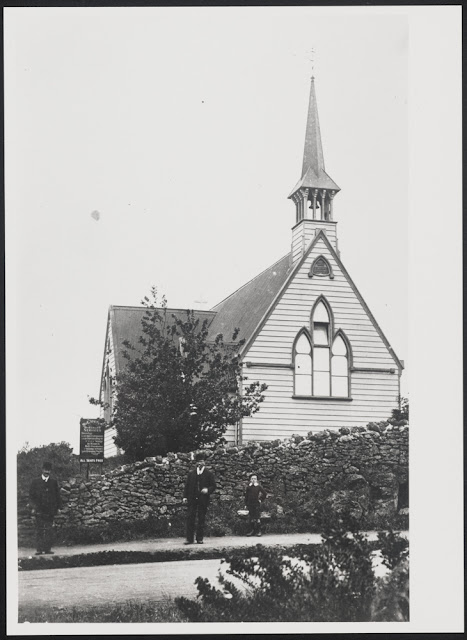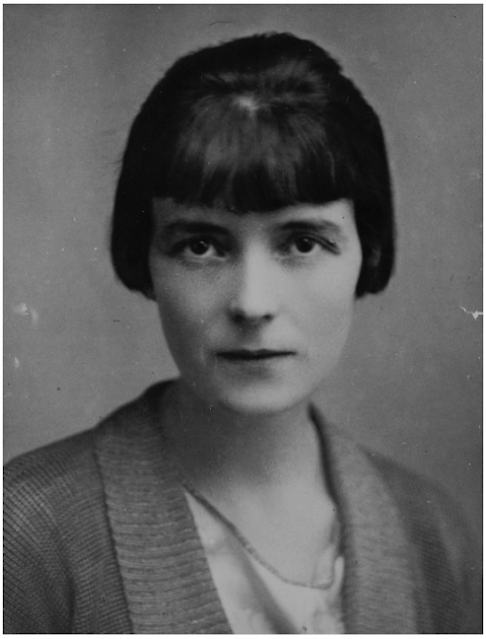Lizzie Frost Rattray: journalist, suffragist and welfare worker
Journalism was a paid employment option for some tough and dedicated women in nineteenth-century Aotearoa. However, many women journalists had to remain freelancers. Lizzie Frost Rattray became one of the first women in New Zealand to become an employed, professional journalist. Lizzie Frost Fenton was born on 22 March 1855 in Dunedin. She was educated in England and France, and returned to Auckland in 1881, where she took charge of the Young Women’s Institute, which was a forerunner of the YWCA.
On 1 March 1883, Lizzie Frost Fenton married William Rattray, a prominent Auckland draper. Rattray was the honorary secretary of the St John Ambulance Association and Lizzie shared her husband’s involvement, organising a street collection which raised the first £500 towards the purchase of the association’s first premises in Rutland Street.
For much of their married life, Lizzie and her husband lived in Mt Albert where she became a prominent member of St Luke’s Anglican Church. She began working enthusiastically for a variety of welfare organizations, including the St Barnabas Association and the Order of the Good Shepherd.
Lizzie was a skilled writer, winning prizes in short story competitions. She was also an artist of ‘considerable ability’ who exhibited work with the Auckland Society of Arts. For several years she was the New Zealand correspondent for the English Gentlewoman magazine. As Mrs. W. Rattray, Lizzie also had some of her stories published in the New Zealand Family Friend and the Observer. Between 17 and 31 August 1889, the Waikato Times serialized in three instalments ‘a short original tale’ in a New Zealand setting by Mrs. Rattray called ‘Evelyn Mossley’s Lover: A Sketch.’ Then between 28 December 1889 and 5 April 1890 the Waikato Times published Lizzie’s story ‘Bristondell, or An Unlucky Marriage.’ She followed this tale with ‘Camella, or An Ignorant Wrangler,’ which was serialised by the Waikato Times between 20 January and 2 June 1891. The missionary magazine Helping Hand printed Lizzie’s tale ‘Mark Turnley’s Temptation’ in its January 1892 issue. Furthermore, in 1892 and 1893, the English journal Cassell’s Family Magazine published instalments of her story ‘Ruha - A Tale of Adventure in the Maori War.’
By this time Lizzie had been noticed by Auckland newspaper proprietor Henry Brett, one of whose news publications was the New Zealand Graphic, Ladies’ Journal and Youth’s Companion. Brett’s concept of the New Zealand Graphic was that it was to be an ‘illustrated paper;’ a lifestyle magazine for the literate and leisured members of the middle class. Brett published some of Lizzie’s work, including ‘Romance on a Auckland Omnibus’ [sic], ‘How to get Married’ (4 July 1891), ‘Between H and N: a Christmas fragment’ (December 1891) and various other New Zealand tales in the Graphic. He soon offered Lizzie an assistant editorial role on the magazine, and about this time she became the Graphic’s Lady Editor.
In this position, Lizzie Frost Rattray was able to influence the lives of her women readers. Her biographer Theresa Graham wrote: ‘Not only were there pages on fashion and social etiquette, but also discussions concerning controversial women’s issues such as the franchise and the involvement of women in a wider range of occupations and sporting activities.’
In 1892, Lizzie was elected to the Auckland branch committee of the Women’s Franchise League. She began to speak publicly on women’s employment, education, and the justice of the franchise cause. In June 1892, Lizzie proposed that men should be allowed to sit on the league’s committee and five men were appointed to it. Then on 11 August 1893, she and others presented a petition to the House of Representatives calling for women’s suffrage.
Wellington writer and historian Redmer Yska discovered that Kathleen’s short story, ‘His Little Friend’ had been published by Cousin Kate in the Graphic for Saturday, 13 October 1900. The story is about an old man’s friendship with a young boy from a poor area of tiny, squalid working-class dwellings (which actually existed in Saunders Lane in Wellington; not far from where the Beauchamps lived in upper-class Tinakori Road.) Suddenly, an unnamed infectious disease kills the little boy. Water-borne diseases like typhoid fever (and even cholera), and other infectious diseases like diptheria, scarlet fever and measles periodically occurred in insanitary nineteenth century Wellington.
The story is presently the earliest formally published work by Mansfield yet discovered. Prior to this, her earliest known works (apart from short pieces in school magazines) date from 1907 when her short stories ‘Vignettes,’ ‘Silhouettes’ and ‘In a Café’ were published in the Melbourne newspaper, the Native Companion. In later life (1922) Katherine Mansfield re-worked material from ‘His Little Friend’ into her longer tale, ‘The Garden Party’, where the rich Sheridans take food from their garden party to give to the poor Scott family after Mr. Scott is killed in a traffic accident.
Early biographer Patricia Grimshaw wrote ‘In the course of a busy life Lizzie Rattray fought hard for the equality of the sexes and it would appear that her intelligence and ability, displayed in writing and administrative work alike, pleaded her cause even more eloquently than her words.’ Lizzie Frost Rattray died in Parnell on 12 August 1931 and was survived by her husband and two sons, William Herbert Widdrington Rattray (Vicar of Henderson, then Clevedon and later Point Chevalier) and solicitor Cyril Mervyn Rattray.
 |
| Image: New Zealand Graphic. Mrs Lizzie Frost Rattray, 1892. Auckland Libraries Heritage Collections, NZG-18920723-735-1. |
Lizzie was also involved with the Girls’ Friendly Society which gave assistance to girls and young women immigrating to Auckland.
 |
| Image: New Zealand Graphic. The Girls’ Friendly Society, 1909. Auckland Libraries Heritage Collections, NZG-19090901-31-4. |
 |
| Image: James D. Richardson. St John Ambulance Association, Rutland Street, 1931. Auckland Libraries Heritage Collections, 4-1513. |
 |
| Image: Unknown photographer. St Luke’s Church, Mt Albert, 1910. Auckland Libraries Heritage Collections, 255A-121. |
By this time Lizzie had been noticed by Auckland newspaper proprietor Henry Brett, one of whose news publications was the New Zealand Graphic, Ladies’ Journal and Youth’s Companion. Brett’s concept of the New Zealand Graphic was that it was to be an ‘illustrated paper;’ a lifestyle magazine for the literate and leisured members of the middle class. Brett published some of Lizzie’s work, including ‘Romance on a Auckland Omnibus’ [sic], ‘How to get Married’ (4 July 1891), ‘Between H and N: a Christmas fragment’ (December 1891) and various other New Zealand tales in the Graphic. He soon offered Lizzie an assistant editorial role on the magazine, and about this time she became the Graphic’s Lady Editor.
 |
In 1892, Lizzie was elected to the Auckland branch committee of the Women’s Franchise League. She began to speak publicly on women’s employment, education, and the justice of the franchise cause. In June 1892, Lizzie proposed that men should be allowed to sit on the league’s committee and five men were appointed to it. Then on 11 August 1893, she and others presented a petition to the House of Representatives calling for women’s suffrage.
Lizzie Frost Rattray was the Lady Editor of the New Zealand Graphic for many years. Part of her editorial role was to preside over the children’s page in the magazine. She took on the pseudonym ‘Cousin Kate,’ and every girl (and some boys) who corresponded with her became a Graphic ‘cousin.’ To write to Cousin Kate, children were instructed to send their letters and stories (write on one side of the page only!) to the Lady Editor at the New Zealand Graphic. In this way, it is likely that Lizzie was the first editor to publish a story by 11-year-old Kathleen Beauchamp, who later became well known as the writer Katherine Mansfield.
 |
| Image: Katherine Mansfield aged 10. Ref: 1/4-015041-F. Alexander Turnbull Library, Wellington, New Zealand. |
Wellington writer and historian Redmer Yska discovered that Kathleen’s short story, ‘His Little Friend’ had been published by Cousin Kate in the Graphic for Saturday, 13 October 1900. The story is about an old man’s friendship with a young boy from a poor area of tiny, squalid working-class dwellings (which actually existed in Saunders Lane in Wellington; not far from where the Beauchamps lived in upper-class Tinakori Road.) Suddenly, an unnamed infectious disease kills the little boy. Water-borne diseases like typhoid fever (and even cholera), and other infectious diseases like diptheria, scarlet fever and measles periodically occurred in insanitary nineteenth century Wellington.
The story is presently the earliest formally published work by Mansfield yet discovered. Prior to this, her earliest known works (apart from short pieces in school magazines) date from 1907 when her short stories ‘Vignettes,’ ‘Silhouettes’ and ‘In a Café’ were published in the Melbourne newspaper, the Native Companion. In later life (1922) Katherine Mansfield re-worked material from ‘His Little Friend’ into her longer tale, ‘The Garden Party’, where the rich Sheridans take food from their garden party to give to the poor Scott family after Mr. Scott is killed in a traffic accident.
 |
| Image: New Zealand Graphic. Photographs of sub-standard housing in Wellington, 1911. Auckland Libraries Heritage Collections, NZG-19110809-22-1. |
 |
| Image: Katherine Mansfield. Murry, M Middleton (Mrs) :Photographs of Katherine Mansfield. Ref: PAColl-5294-1. Alexander Turnbull Library, Wellington, New Zealand. |
Early biographer Patricia Grimshaw wrote ‘In the course of a busy life Lizzie Rattray fought hard for the equality of the sexes and it would appear that her intelligence and ability, displayed in writing and administrative work alike, pleaded her cause even more eloquently than her words.’ Lizzie Frost Rattray died in Parnell on 12 August 1931 and was survived by her husband and two sons, William Herbert Widdrington Rattray (Vicar of Henderson, then Clevedon and later Point Chevalier) and solicitor Cyril Mervyn Rattray.
 |
Author: Christopher Paxton, Heritage Engagement
References
Theresa B. Graham, ‘Rattray, Lizzie Frost’ in Dictionary of New Zealand biography, 1993.
Patricia Grimshaw, ‘Rattray, Lizzie Frost’ in An encyclopedia of New Zealand, 1966.
Ian F. Grant, Lasting Impressions: The story of New Zealand’s newspapers, 1840-1920, Masterton, 2018.
Janet McCallum, Women and their words: notable pioneers in New Zealand journalism, Masterton, 2009.
J.E. Traue, ‘Nineteenth century novels and novellas published as serials in New Zealand, Australian and British newspapers and never published as monographs: a checklist,’ Journal of New Zealand Studies, NS20, 2015, pp. 10-23.
Redmer Yska, A strange beautiful excitement: Katherine Mansfield’s Wellington 1888-1903, Dunedin, 2017.
References
Patricia Grimshaw, ‘Rattray, Lizzie Frost’ in An encyclopedia of New Zealand, 1966.
Ian F. Grant, Lasting Impressions: The story of New Zealand’s newspapers, 1840-1920, Masterton, 2018.
Janet McCallum, Women and their words: notable pioneers in New Zealand journalism, Masterton, 2009.
J.E. Traue, ‘Nineteenth century novels and novellas published as serials in New Zealand, Australian and British newspapers and never published as monographs: a checklist,’ Journal of New Zealand Studies, NS20, 2015, pp. 10-23.
Redmer Yska, A strange beautiful excitement: Katherine Mansfield’s Wellington 1888-1903, Dunedin, 2017.

Great piece Christopher!! And go Lizzie!!
ReplyDelete